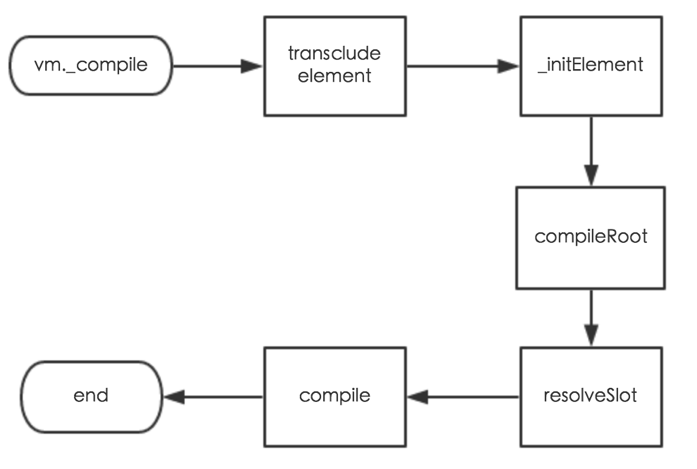Vue 源码解析:深入响应式原理(中)
Directive
Vue 指令类型很多,限于篇幅,我们不会把所有指令的解析过程都介绍一遍,这里结合前面的例子只介绍 v-text 指令的解析过程,其他指令的解析过程也大同小异。
前面我们提到了 Vue 实例创建的生命周期,在给 data 添加 Observer 之后,有一个过程是调用 vm.compile 方法对模板进行编译。compile 方法的源码定义如下:
<!-源码目录:src/instance/internal/lifecycle.js-->
Vue.prototype._compile = function (el) {
var options = this.$options
// transclude and init element
// transclude can potentially replace original
// so we need to keep reference; this step also injects
// the template and caches the original attributes
// on the container node and replacer node.
var original = el
el = transclude(el, options)
this._initElement(el)
// handle v-pre on root node (#2026)
if (el.nodeType === 1 && getAttr(el, 'v-pre') !== null) {
return
}
// root is always compiled per-instance, because
// container attrs and props can be different every time.
var contextOptions = this._context && this._context.$options
var rootLinker = compileRoot(el, options, contextOptions)
// resolve slot distribution
resolveSlots(this, options._content)
// compile and link the rest
var contentLinkFn
var ctor = this.constructor
// component compilation can be cached
// as long as it's not using inline-template
if (options._linkerCachable) {
contentLinkFn = ctor.linker
if (!contentLinkFn) {
contentLinkFn = ctor.linker = compile(el, options)
}
}
// link phase
// make sure to link root with prop scope!
var rootUnlinkFn = rootLinker(this, el, this._scope)
var contentUnlinkFn = contentLinkFn
? contentLinkFn(this, el)
: compile(el, options)(this, el)
// register composite unlink function
// to be called during instance destruction
this._unlinkFn = function () {
rootUnlinkFn()
// passing destroying: true to avoid searching and
// splicing the directives
contentUnlinkFn(true)
}
// finally replace original
if (options.replace) {
replace(original, el)
}
this._isCompiled = true
this._callHook('compiled')
}我们可以通过下图来看一下这个方法编译的主要流程:
这个过程通过 el = transclude(el, option) 方法把 template 编译成一段 document fragment,拿到 el 对象。而指令解析部分就是通过 compile(el, options) 方法实现的。接下来我们看一下 compile 方法的实现,它的源码定义如下:
<!-源码目录:src/compiler/compile.js-->
export function compile (el, options, partial) {
// link function for the node itself.
var nodeLinkFn = partial || !options._asComponent
? compileNode(el, options)
: null
// link function for the childNodes
var childLinkFn =
!(nodeLinkFn && nodeLinkFn.terminal) &&
!isScript(el) &&
el.hasChildNodes()
? compileNodeList(el.childNodes, options)
: null
/**
* A composite linker function to be called on a already
* compiled piece of DOM, which instantiates all directive
* instances.
*
* @param {Vue} vm
* @param {Element|DocumentFragment} el
* @param {Vue} [host] - host vm of transcluded content
* @param {Object} [scope] - v-for scope
* @param {Fragment} [frag] - link context fragment
* @return {Function|undefined}
*/
return function compositeLinkFn (vm, el, host, scope, frag) {
// cache childNodes before linking parent, fix #657
var childNodes = toArray(el.childNodes)
// link
var dirs = linkAndCapture(function compositeLinkCapturer () {
if (nodeLinkFn) nodeLinkFn(vm, el, host, scope, frag)
if (childLinkFn) childLinkFn(vm, childNodes, host, scope, frag)
}, vm)
return makeUnlinkFn(vm, dirs)
}
}compile 方法主要通过 compileNode(el, options) 方法完成节点的解析,如果节点拥有子节点,则调用 compileNodeList(el.childNodes, options) 方法完成子节点的解析。compileNodeList 方法其实就是遍历子节点,递归调用 compileNode 方法。因为 DOM 元素本身就是树结构,这种递归方法也就是常见的树的深度遍历方法,这样就可以完成整个 DOM 树节点的解析。接下来我们看一下 compileNode 方法的实现,它的源码定义如下:
<!-源码目录:src/compiler/compile.js-->
function compileNode (node, options) {
var type = node.nodeType
if (type === 1 && !isScript(node)) {
return compileElement(node, options)
} else if (type === 3 && node.data.trim()) {
return compileTextNode(node, options)
} else {
return null
}
}compileNode 方法对节点的 nodeType 做判断,如果是一个非 script 普通的元素(div、p等);则调用 compileElement(node, options) 方法解析;如果是一个非空的文本节点,则调用 compileTextNode(node, options) 方法解析。我们在前面的例子中解析的是非空文本节点 count: {{times}},这实际上是 v-text 指令,它的解析是通过 compileTextNode 方法实现的。接下来我们看一下 compileTextNode 方法,它的源码定义如下:
<!-源码目录:src/compiler/compile.js-->
function compileTextNode (node, options) {
// skip marked text nodes
if (node._skip) {
return removeText
}
var tokens = parseText(node.wholeText)
if (!tokens) {
return null
}
// mark adjacent text nodes as skipped,
// because we are using node.wholeText to compile
// all adjacent text nodes together. This fixes
// issues in IE where sometimes it splits up a single
// text node into multiple ones.
var next = node.nextSibling
while (next && next.nodeType === 3) {
next._skip = true
next = next.nextSibling
}
var frag = document.createDocumentFragment()
var el, token
for (var i = 0, l = tokens.length; i < l; i++) {
token = tokens[i]
el = token.tag
? processTextToken(token, options)
: document.createTextNode(token.value)
frag.appendChild(el)
}
return makeTextNodeLinkFn(tokens, frag, options)
}compileTextNode 方法首先调用了 parseText 方法对 node.wholeText 做解析。主要通过正则表达式解析 count: {{times}} 部分,我们看一下解析结果,如下图所示:
解析后的 tokens 是一个数组,数组的每个元素则是一个 Object。如果是 count: 这样的普通文本,则返回的对象只有 value 字段;如果是 {{times}} 这样的插值,则返回的对象包含 html、onTime、tag、value 等字段。
接下来创建 document fragment,遍历 tokens 创建 DOM 节点插入到这个 fragment 中。在遍历过程中,如果 token 无 tag 字段,则调用 document.createTextNode(token.value) 方法创建 DOM 节点;否则调用processTextToken(token, options) 方法创建 DOM 节点和扩展 token 对象。我们看一下调用后的结果,如下图所示:
可以看到,token 字段多了一个 descriptor 属性。这个属性包含了几个字段,其中 def 表示指令相关操作的对象,expression 为解析后的表达式,filters 为过滤器,name 为指令的名称。
在compileTextNode 方法的最后,调用 makeTextNodeLinkFn(tokens, frag, options) 并返回该方法执行的结果。接下来我们看一下 makeTextNodeLinkFn 方法,它的源码定义如下:
<!-源码目录:src/compiler/compile.js-->
function makeTextNodeLinkFn (tokens, frag) {
return function textNodeLinkFn (vm, el, host, scope) {
var fragClone = frag.cloneNode(true)
var childNodes = toArray(fragClone.childNodes)
var token, value, node
for (var i = 0, l = tokens.length; i < l; i++) {
token = tokens[i]
value = token.value
if (token.tag) {
node = childNodes[i]
if (token.oneTime) {
value = (scope || vm).$eval(value)
if (token.html) {
replace(node, parseTemplate(value, true))
} else {
node.data = _toString(value)
}
} else {
vm._bindDir(token.descriptor, node, host, scope)
}
}
}
replace(el, fragClone)
}
}makeTextNodeLinkFn 这个方法什么也没做,它仅仅是返回了一个新的方法 textNodeLinkFn。往前回溯,这个方法最终作为 compileNode 的返回值,被添加到 compile 方法生成的 childLinkFn 中。
我们回到 compile 方法,在 compile 方法的最后有这样一段代码:
<!-源码目录:src/compiler/compile.js-->
return function compositeLinkFn (vm, el, host, scope, frag) {
// cache childNodes before linking parent, fix #657
var childNodes = toArray(el.childNodes)
// link
var dirs = linkAndCapture(function compositeLinkCapturer () {
if (nodeLinkFn) nodeLinkFn(vm, el, host, scope, frag)
if (childLinkFn) childLinkFn(vm, childNodes, host, scope, frag)
}, vm)
return makeUnlinkFn(vm, dirs)
}compile 方法返回了 compositeLinkFn,它在 Vue.prototype._compile 方法执行时,是通过 compile(el, options)(this, el) 调用的。compositeLinkFn 方法执行了 linkAndCapture 方法,它的功能是通过调用 compile 过程中生成的 link 方法创建指令对象,再对指令对象做一些绑定操作。linkAndCapture 方法的源码定义如下:
<!-源码目录:src/compiler/compile.js-->
function linkAndCapture (linker, vm) {
/* istanbul ignore if */
if (process.env.NODE_ENV === 'production') {
// reset directives before every capture in production
// mode, so that when unlinking we don't need to splice
// them out (which turns out to be a perf hit).
// they are kept in development mode because they are
// useful for Vue's own tests.
vm._directives = []
}
var originalDirCount = vm._directives.length
linker()
var dirs = vm._directives.slice(originalDirCount)
dirs.sort(directiveComparator)
for (var i = 0, l = dirs.length; i < l; i++) {
dirs[i]._bind()
}
return dirs
}linkAndCapture 方法首先调用了 linker 方法,它会遍历 compile 过程中生成的所有 linkFn 并调用,本例中会调用到之前定义的 textNodeLinkFn。这个方法会遍历 tokens,判断如果 token 的 tag 属性值为 true 且 oneTime 属性值为 false,则调用 vm.bindDir(token.descriptor, node, host, scope) 方法创建指令对象。 vm._bindDir 方法的源码定义如下:
<!-源码目录:src/instance/internal/lifecycle.js-->
Vue.prototype._bindDir = function (descriptor, node, host, scope, frag) {
this._directives.push(
new Directive(descriptor, this, node, host, scope, frag)
)
}Vue.prototype._bindDir 方法就是根据 descriptor 实例化不同的 Directive 对象,并添加到 vm 实例 directives 数组中的。到这一步,Vue.js 从解析模板到生成 Directive 对象的步骤就完成了。接下来回到 linkAndCapture 方法,它对创建好的 directives 进行排序,然后遍历 directives 调用 dirs[i]._bind 方法对单个directive做一些绑定操作。dirs[i]._bind方法的源码定义如下:
<!-源码目录:src/directive.js-->
Directive.prototype._bind = function () {
var name = this.name
var descriptor = this.descriptor
// remove attribute
if (
(name !== 'cloak' || this.vm._isCompiled) &&
this.el && this.el.removeAttribute
) {
var attr = descriptor.attr || ('v-' + name)
this.el.removeAttribute(attr)
}
// copy def properties
var def = descriptor.def
if (typeof def === 'function') {
this.update = def
} else {
extend(this, def)
}
// setup directive params
this._setupParams()
// initial bind
if (this.bind) {
this.bind()
}
this._bound = true
if (this.literal) {
this.update && this.update(descriptor.raw)
} else if (
(this.expression || this.modifiers) &&
(this.update || this.twoWay) &&
!this._checkStatement()
) {
// wrapped updater for context
var dir = this
if (this.update) {
this._update = function (val, oldVal) {
if (!dir._locked) {
dir.update(val, oldVal)
}
}
} else {
this._update = noop
}
var preProcess = this._preProcess
? bind(this._preProcess, this)
: null
var postProcess = this._postProcess
? bind(this._postProcess, this)
: null
var watcher = this._watcher = new Watcher(
this.vm,
this.expression,
this._update, // callback
{
filters: this.filters,
twoWay: this.twoWay,
deep: this.deep,
preProcess: preProcess,
postProcess: postProcess,
scope: this._scope
}
)
// v-model with inital inline value need to sync back to
// model instead of update to DOM on init. They would
// set the afterBind hook to indicate that.
if (this.afterBind) {
this.afterBind()
} else if (this.update) {
this.update(watcher.value)
}
}
}Directive.prototype._bind 方法的主要功能就是做一些指令的初始化操作,如混合 def 属性。def 是通过 this.descriptor.def 获得的,this.descriptor 是对指令进行相关描述的对象,而 this.descriptor.def 则是包含指令相关操作的对象。比如对于 v-text 指令,我们可以看一下它的相关操作,源码定义如下:
<!-源码目录:src/directives/public/text.js-->
export default {
bind () {
this.attr = this.el.nodeType === 3
? 'data'
: 'textContent'
},
update (value) {
this.el[this.attr] = _toString(value)
}
}v-text 的 def 包含了 bind 和 update 方法,Directive 在初始化时通过 extend(this, def) 方法可以对实例扩展这两个方法。Directive 在初始化时还定义了 this.update 方法,并创建了 Watcher,把 this.update 方法作为 Watcher 的回调函数。这里把 Directive 和 Watcher 做了关联,当 Watcher 观察到指令表达式值变化时,会调用 Directive 实例的 _update 方法,最终调用 v-text 的 update 方法更新 DOM 节点。
至此,vm 实例中编译模板、解析指令、绑定 Watcher 的过程就结束了。接下来我们看一下 Watcher 的实现,了解 Directive 和 Observer 之间是如何通过 Watcher 关联的。
共同学习,写下你的评论
评论加载中...
作者其他优质文章








